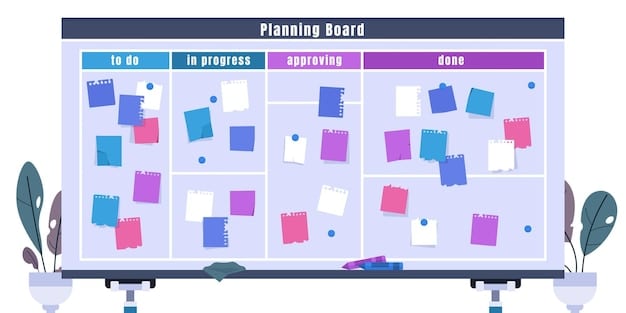The 5S System: Your Guide to Workspace Efficiency and Clutter Reduction

The 5S System, originating from Japan, is a methodology focused on creating a clean, organized, and efficient workspace designed to improve productivity, reduce waste, and enhance overall operational effectiveness.
Is your workspace holding you back? Discover how the 5S System: Organize Your Workspace for Maximum Efficiency and Reduce Clutter can transform your productivity and eliminate unnecessary stress.
Understanding the 5S System: A Foundation for Efficiency
The 5S System is more than just tidying up; it’s a comprehensive methodology aimed at optimizing your workspace for maximum efficiency. Originating from Japanese manufacturing, the 5S principles provide a structured approach to eliminate waste, improve workflow, and create a safer, more productive environment.
The Core Principles of 5S
The 5S System is based on five key Japanese terms, each representing a step in the process of creating and maintaining an organized workspace. Understanding these principles is essential for successful implementation.
- Seiri (Sort): This involves removing unnecessary items from the workspace, keeping only what is essential for the current tasks.
- Seiton (Set in Order): Arranging the necessary items in a logical and accessible manner, ensuring everything has a designated place.
- Seiso (Shine): Cleaning the workspace regularly to maintain cleanliness and identify potential issues early.
- Seiketsu (Standardize): Establishing standards and procedures to maintain the organized state achieved in the previous steps.
- Shitsuke (Sustain): Maintaining discipline and adherence to the established standards through ongoing training and reinforcement.
By adhering to these principles, organizations and individuals can create a workspace that is not only clean and organized but also highly efficient and conducive to productivity.
Step 1: Seiri (Sort) – Eliminating the Unnecessary
The first step in the 5S System, Seiri (Sort), focuses on identifying and removing unnecessary items from your workspace. This decluttering process is crucial for creating a more efficient and less distracting environment.
Sorting involves carefully evaluating each item in your workspace and determining whether it is truly needed. Items that are not essential should be removed or relocated to a storage area. This process reduces clutter and frees up valuable space.

Practical Tips for Sorting
Effectively executing Seiri requires a systematic approach. Here are some practical tips to guide you through the sorting process:
- Create a Red Tag Area: Designate an area for items that are questionable. Tag these items and set a deadline to decide their fate.
- Ask Key Questions: For each item, ask yourself: “Is this item necessary?”, “When was the last time I used it?”, and “If I needed it, could I easily find it?”.
- The 30-Day Rule: If you haven’t used an item in the past 30 days and can’t foresee using it in the next 30 days, it’s likely unnecessary.
Regularly revisit the sorting process to prevent clutter from accumulating over time. This ongoing effort ensures that your workspace remains efficient and organized.
Step 2: Seiton (Set in Order) – Arranging for Efficiency
Seiton (Set in Order) is the second step in the 5S System, emphasizing the importance of arranging essential items in a logical and accessible manner. This ensures that everything has a designated place, making it easier to find and use when needed.
Setting items in order involves analyzing your workflow and determining the most efficient arrangement for your tools and materials. The goal is to minimize wasted time and effort in searching for items.
Strategies for Effective Set in Order
Implementing Seiton effectively requires careful planning and organization. Here are some strategies to help you set your workspace in order:
- Label Everything: Clearly label shelves, drawers, and containers to identify their contents quickly and easily.
- Use Visual Cues: Implement color-coding or other visual cues to further enhance organization and accessibility.
- Optimize Placement: Position frequently used items within easy reach, while less frequently used items can be stored further away.
By strategically arranging your workspace, you can create a more streamlined and efficient workflow, reducing the time and effort required to complete tasks.
Step 3: Seiso (Shine) – Maintaining a Clean Workspace
Seiso (Shine) is the third step in the 5S System, focusing on maintaining a clean and tidy workspace. Regular cleaning not only improves the appearance of the area but also helps identify potential issues early on.
Shining involves establishing a routine for cleaning your workspace regularly. This includes sweeping, wiping down surfaces, and removing any debris or spills. A clean workspace is essential for maintaining a safe and productive environment.
Benefits of Regular Cleaning
Committing to Seiso offers numerous benefits beyond just aesthetics. A clean workspace can lead to:
- Improved Safety: Reducing clutter and debris minimizes the risk of accidents and injuries.
- Increased Productivity: A clean and organized workspace promotes focus and reduces distractions.
- Early Problem Detection: Regular cleaning allows you to identify potential issues, such as leaks or equipment malfunctions, before they escalate.
By making Seiso a regular part of your routine, you can maintain a workspace that is not only clean but also safe and conducive to productivity.
Step 4: Seiketsu (Standardize) – Establishing Consistent Practices
Seiketsu (Standardize) is the fourth step in the 5S System, emphasizing the importance of establishing standards and procedures to maintain the organized state achieved in the previous steps. Standardization ensures that the benefits of the 5S System are sustained over time.
Standardizing involves creating clear guidelines and protocols for sorting, setting in order, and shining. These standards should be documented and communicated to all members of the team or household to ensure consistency.

Developing Effective Standards
To create effective standards, consider the following:
Creating checklists and schedules is a practical way to standardize the 5S process. Make sure all members understand why these routines are necessary and their implementation is essential.
- Document Procedures: Clearly document the steps for sorting, setting in order, and shining in a written format.
- Use Visual Aids: Incorporate visual aids, such as photos or diagrams, to illustrate the desired state of the workspace.
- Regular Audits: Conduct regular audits to ensure that the standards are being followed and identify any areas for improvement.
By establishing clear standards, you can create a culture of consistency and ensure that the benefits of the 5S System are sustained over time.
Step 5: Shitsuke (Sustain) – Maintaining Discipline and Commitment
Shitsuke (Sustain) is the fifth and final step in the 5S System, focusing on maintaining discipline and commitment to the established standards. Sustaining the 5S principles requires ongoing training, reinforcement, and a commitment to continuous improvement.
Sustaining involves fostering a culture of accountability and responsibility within the team or household. Regular training, feedback, and recognition can help reinforce the importance of the 5S System and encourage adherence to the standards.
Strategies for Sustaining the 5S System
Successfully sustaining the 5S System requires a long-term commitment and a proactive approach. Here are some strategies to help you maintain discipline and commitment:
- Regular Training: Provide ongoing training to reinforce the principles of the 5S System and address any questions or concerns.
- Performance Monitoring: Track progress and identify any areas where performance is lagging.
- Lead by Example: Leaders should demonstrate their commitment to the 5S System by consistently following the standards and encouraging others to do the same.
By fostering a culture of discipline and commitment, you can ensure that the benefits of the 5S System are sustained over the long term.
| Key Point | Brief Description |
|---|---|
| 🧹 Seiri (Sort) | Remove unnecessary items to declutter your workspace. |
| 🗂️ Seiton (Set in Order) | Arrange essential items methodically for easy access. |
| ✨ Seiso (Shine) | Keep your workspace clean and tidy regularly. |
| ⚙️ Seiketsu (Standardize) | Establish standards and procedures in order to maintain the first 3 steps. |
Frequently Asked Questions About the 5S System
▼
The 5S System is a methodology developed in Japan focused on creating a clean, organized, and efficient workspace. It helps improve productivity and reduce wasted resources.
▼
A well-organized space reduces time wasted searching for items, minimizes distractions, and promotes a safer and more conducive environment, boosting productivity.
▼
The frequency depends on your workspace, but regular shineso and setting activities should be performed at least weekly. Other activities may be performed monthly or quarterly.
▼
Absolutely! The 5S System is versatile and can be applied to any workspace, including a home office, to enhance organization and productivity, regardless of size or industry.
▼
Common challenges include resistance to change, lack of commitment, and difficulty sustaining the process. Overcoming these obstacles requires strong leadership and ongoing reinforcement.
Conclusion
Mastering the 5S System provides a solid strategy to improve both personal and organizational productivity. From decluttering the workspace to establishing routines, the 5S principles foster a more efficient, safe, and satisfying environment. By committing to these steps, you can unlock greater efficiency and reduce clutter.





